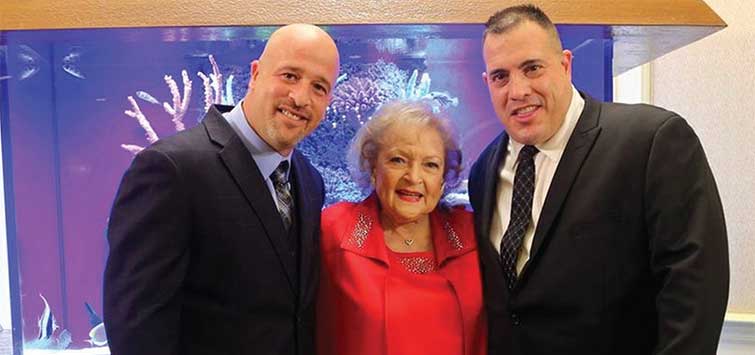Fish Tank Kings: Living the Dream
Author: Shari Horowitz
Follow the guys at Living Color Enterprises, Inc., who specialize in making spectacular aquarium setups for a wide range of clients from celebrities to public aquariums, on the newest aquarium reality TV show Fish Tank Kings.
Caught in a Pickle
The Miami Marlins' request for a backstop aquarium seemed impossible. How could you put an aquarium where it could be hit by baseballs flying at over 80 miles per hour? Living Color Enterprises, Inc.—focus of Nat Geo Wild’s new reality TV show Fish Tank Kings—proved that not only could it be done, but it could be done with style.
A Bulletproof Aquarium?
Mat Roy, President of Living Color, is enthusiastic about all kinds of aquarium builds. He is known for promising the world to his clients—offering everything from the backstop aquarium to using a submarine to acquire fish for a deep-water themed aquarium—and then expects his team to deliver the results.
In the first episode, Mat is approached by David Samson, President of the Miami Marlins, about installing a fish tank at the new Marlins stadium. “He said he wanted to put them on the field and replace part of the backstop, and I thought immediately, well that’s just kind of nuts,” Mat explained, adding, “Obviously the first concern was how do we protect the fish?”
Good Vibrations
After carefully coming up with a design, the team figured out a way to keep vibration out: The tanks are set in neoprene, which sends vibration through the concrete instead of the acrylic, is made out of stainless steel, and is covered with a fiberglass coating. Perhaps most important, there is a ¼-inch-thick, polycarbonate, bullet-resistant shield in front of the aquarium that will withstand an object hitting it at close to 100 miles per hour. Between the shield and the tank is an air gap about 1½ inches wide, preventing anything from hitting the aquarium directly.
“We took pitching machines and a player, and we were hurling baseballs at close to 200 miles per hour, and we studied the top of the aquarium. The aquarium remained very still, there was absolutely no vibration that hit the water,” said Mat. “The president of the Marlins has since, with fish in the aquarium, thrown balls at it as well to see if there were any impacts on the fish. It had absolutely no effect on the fish, whatsoever. They’ve had multiple home games so far; we don’t see any signs of disease or stress. They’re all eating well and doing well.”
Natural-Looking Setups
Of course, not all of their builds are as controversial as the Miami Marlins aquarium. Living Color actually did not even start in the aquarium installation business; it started as an aquarium-maintenance company in 1988.
Growing Demands
As the client base grew, so did their demands. People started wanting larger aquariums, changes to their existing aquariums, or new fish. Originally these projects were simply coordinated by Living Color, with different manufacturers doing each component, but eventually the company moved the manufacturing work in-house. Then the business expanded from residential clients into commercial ones and ultimately into themed exhibits for places like public aquariums and theme parks.
Living Color is now involved in all aspects of production, from creating the aquarium and insets to the cabinetry surrounding it. All the setups are considered turnkey installations, meaning that all the filtration and equipment are ready to go for the client.
A Slice of Ocean
They are also known for creating setups that have a natural look to them. “We don’t really do whimsical, weird aquariums. When a customer comes to Living Color, they’re looking for a slice of the ocean. We do realistic replications of the actual environment, and that’s what we’re about and that’s what we do and excel at,” explained Francis Yupangco, a self-described lifelong fish geek and Living Color’s head marine biologist.
“Living Color would lean more towards the fish in the way that we design an aquarium, and it’s not just the filtration—which of course is the heartbeat—but more importantly what is part of the exhibit on the inside. We want to create swim-throughs, and caves, and places for fish to hide, so they will be less under stress, and they feel more comfortable, and they can create their own little home, if you will, within the reef systems that we build. We explain that to the clients, and they understand that,” said Mat.
Fish and Famous Tanks
In certain cases, it is even more important than usual to accurately depict the ocean, as shown in the episode featuring a very popular nationwide restaurant chain: the Rainforest CafÉ. Francis found the Rainforest CafÉ tanks to be a particularly fun challenge.
Rainforest CafÉ
“Our client in that instance was not only the Rainforest CafÉ, but their director of biology, Jim Prappas, and he is in charge of 28 Rainforest locations plus a large number of public aquariums for the Landry family. He is very, very well respected in the public aquarium industry, and he knows exactly what he wants—he wants things to look a particular way and be very accurate. So what we had to do was come up with customized colors on the corals, paint the reefs a particular way, and develop some new corals for our collection,” he said.
For the Kids
Living Color’s Production and Safety Manager, Jose Blanco, also finds it important to use fish tanks to help teach children. In one episode featuring Miami Heat basketball player Alonzo Mourning, kids from the Overtown Youth Center make a trip to Living Color to design inserts for the freshwater aquarium being built for the center. “That project for me personally was really rewarding to see; these kids are really enthusiastic about the project, and to have that aquarium not only as something that they can work with and stuff, but something educational for them,” he said.
“Just to add to that, I think that when the average child keeps a small, 10-gallon aquarium, when they have a goldfish or betta in there, they’re going to gain a greater appreciation for the natural world. It’s just human nature that you’re going to want to protect or care about something that you know about or you’re educated about. In a greater sense, I think that aquariums are a great tool for conservation and teach young people how delicate the aquatic world is,” said Francis.
A True Reality Show
The show features a large number of species, and Francis stresses that every one of them is taken care of correctly. He mentioned that National Geographic reviewed each episode for accuracy and asked for scientific research to back up claims made in the show when appropriate.
According to Mat, “I think the show is unique, and I think it holds true to the industry. Like any reality television show, there is some scripting because they’re trying to throw out worst-case scenarios and best-case scenarios. But at the end of the day, Living Color is always the hero, getting the project done, and more importantly, every single one of those projects is done correctly. That was the foremost of everything that we were doing—we were not going to rush into a job just to get it done to put it on film. These are real projects; these are real clients. That’s the way it is.”
Fish Tank Kings airs Saturdays at 10 p.m. (ET/PT) on Nat Geo Wild.
See the full article on TFH Digital http://www.tfhdigital.com/tfh/201207#pg97

.png?h=595&iar=0&w=2781&hash=5FD5E69473BCC22199FBFA2FB71B6033)



